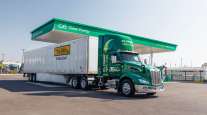Senior Reporter
Cummins Posts Q3 Income, Revenue Gains

[Stay on top of transportation news: Get TTNews in your inbox.]
Cummins Inc. reported that strong medium- and heavy-duty engine sales amid global growth, despite moderating demand in China, led to increased net income and revenue in the fiscal third quarter.
For the period ended Oct. 3, Cummins reported net income attributable to the company of $534 million, or $3.69 per diluted share, compared with $501 million, $3.36, a year earlier.
Revenue increased to $5.9 billion compared with $5.1 billion in the 2020 period that ended Sept. 27.

Linebarger
Along with the gains came “higher freight and logistics expenses, rising materials costs and other manufacturing inefficiencies associated with the ongoing supply chain challenges in our industry,” Cummins Chairman and CEO Tom Linebarger said during the earnings call Nov. 2.
Engine segment sales rose 22% to $2.6 billion compared with a year earlier. Cummins cited strong demand in the North American truck market. Off-highway revenue increased 21% driven by strong demand in North American, Asian Pacific and European construction markets.
Industry production of heavy-duty trucks in the third quarter hit 55,000, Linebarger said, an increase of 10% compared with the 2020 level. Cummins sold 22,000 heavy-duty engines in the same period, up 30% compared with 2020 levels.
The industry produced 26,000 medium-duty units in the quarter, he said, a decrease of 5% from the 2020 level. Cummins notched sales of 23,000 in that segment — a 25% increase compared with a year earlier.
Among the quarterly highlights the company cited were:
- Cummins will bring to market here in 2024 a 15-liter natural gas engine for heavy-duty trucks (launched in China), calling it an important part of the company’s strategy for its path to zero emissions — which also includes other new powertrains including advanced diesel, hydrogen engines, hybrids, battery-electric and fuel cells along with an increased use of low-carbon fuels and renewable electricity and related infrastructure. Cummins intends to lower emissions from newly sold products by 30% by 2030 and a goal of carbon neutrality by 2050, aligned with the Paris Climate Accord targets. “All Cummins engine platforms are being designed with this same fuel flexibility,” Linebarger said. “At the same time we are working with Chevron and others to increase the availability of renewable natural gas and other renewable fuels to ensure the infrastructure is in place to meet our customers’ needs.”
- He said hydrogen combustion is a good answer. It’s just not as efficient as a fuel cell. “So if you’re running a longhaul heavy-duty truck where fuel is your No. 1 cost or power energy is, then that efficiency increase from a fuel cell is going to be worth it to you. If you have a relatively short range or you have a vocational truck, our view is maybe a hydrogen engine might work for you, especially if the conversion to fuel cell is too expensive. So our view is there is a place for both. But if you want to think what’s going to really drive the transportation economy 20 years, 15 years from now, you’re going to need the efficiency that a fuel cell, especially with an electric system, is going to provide. So our feeling still is fuel cells win for the majority of the trucking industry. But hydrogen engines are a real, real addition to the portfolio of products that are, can be, available across our markets.”
- Also, it will launch a set of software features to integrate its powertrains with automated driving system technologies. Cummins is actively testing more than 100 vehicles in coordination with ADS technology companies to ensure seamless powertrain integration as ADS solutions enter commercial vehicle markets globally.
In its component segment, sales reached $1.8 billion, an increase of 16% compared with a year earlier.
Earnings release: @Cummins reports third quarter 2021 results. More: https://t.co/6FtAQTlRCL #Cummins — Cummins Inc. (@Cummins) November 2, 2021
Revenue in its new power segment, which includes fuel cell systems, battery-electric systems and electrolyzers, rose 28% to $23 million.
For the full year, Cummins lowered its forecast for heavy-duty truck production in North America to 228,000 units, up 25% compared with 2020, but below its prior guidance of 264,000 units.
“This is again due to the supply chain constraints impacting our customers rather than a lack of end-user demand,” Linebarger said, citing a common industrywide refrain.
Cummins lowered its medium-duty production forecast to 118,000 units, up 15% year-over-year, but below its prior guidance of 134,000 units.
“We expect our engine shipments for pickup trucks in North America to be up 25% compared to 2020, an increase of 7.5% from our expectations three months ago,” Linebarger added.
Want more news? Listen to today's daily briefing below or go here for more info:




